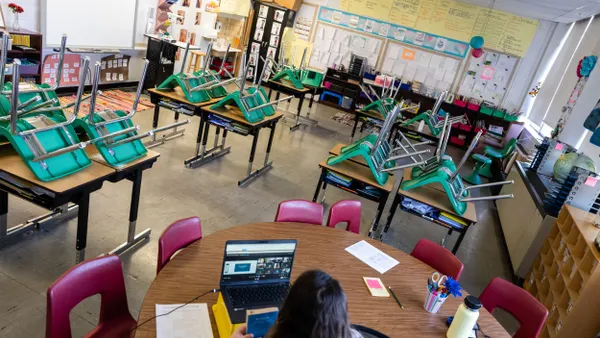Dive Brief:
- The new 2021 School Meals Report Card report recommends the U.S. Department of Agriculture establish a standard with a “short timeline” to limit added sugars in school meals to no more than 10% of total calories. There is currently no USDA standard on added sugars. Schools should also phase out harmful artificial sweeteners and synthetic dyes quickly, the report advises.
- In 2020-21, the largest foodservice companies supplying schools overall met science-based standards for sodium, added sugars, artificial sweeteners, whole grains and synthetic food dyes, according to the report by the Center for Science in the Public Interest.
- Report co-author Meghan Maroney said progress toward raising school nutrition standards has slowed in recent years, but the report reveals companies are well-positioned to reduce added sugars and eliminate artificial sweeteners and synthetic dyes if the USDA were to make those changes.
Dive Insight:
While the report suggests USDA tighten its school nutrition guidelines, two school-based nutrition experts said the logistics of limiting added sugars anytime soon would be hard on their districts given the disrupted supply chain impacting their school meal production.
Acknowledging the effects of the supply chain crisis, USDA already waived financial penalties for any meal pattern shortcomings for the remainder of the 2021-22 school year.
Teresa Brown, administrator of ancillary service for St. Charles Parish Public Schools in Louisiana, said she’s certain it would cost districts more money to navigate new USDA guidelines by training staff or paying for more expensive products.
“It is not reasonable right now” to add new USDA guidelines for schools, Brown said. “With labor shortages, supply chain, there are so many things we’re trying to balance right now while feeding kids, while making sure that the meals are safe.”
Current school nutrition standards do not address added sugars nor do they meet 2020 Dietary Guidelines for Americans’ recommendations, the report said. Companies should also prioritize revisiting product formulation for foods that often contain added sugars in school meals, including flavored skim milk, sweetened cereals and condiments, the report advised.
Overconsumption of added sugar — which CSPI hopes to limit in schools — puts children at risk for health complications including obesity, tooth decay and heart disease, according to the American Academy of Pediatrics.
The CSPI report also said the COVID-19 pandemic may have led to a further spike in childhood obesity. A Tufts University study found U.S. children consistently eat their healthiest meals at school. The research also noted the significant improvements in nutritional food quality in schools rose after passage of the federal Healthy, Hunger-Free Kids Act in 2010.
In the first nine months of the pandemic, the School Nutrition Association said USDA data revealed that school meal programs served 30% fewer meals to students. The closure of schools in the beginning of the pandemic caused a $2.1 billion loss in federal revenue for school meal programs, SNA said.
“We understand that flexibilities are needed, but the pandemic has shown us the importance of school meals and that healthy school meals are more important than ever for children,” Maroney said. “Now is not the time to roll back standards. Now is the time to commit to realistic timelines for science-based standards.”
Yet, Brown said, adding more restrictions on school nutrition programs will not make a difference in addressing child obesity.
“We want to be a part of the child obesity solution, but we are not the reason for it,” Brown said. “So we can’t solve it by ourselves.”
In fact, Brown suggests instead of adding more regulations to school meals, communities work to educate families about nutrition and exercise. Maybe officials could reevaluate the quality of food options covered by the Supplemental Nutrition Assistance Program, she said.
There should also be more support for what’s working in communities surrounding school nutrition, said Ashley Powell, child nutrition director for Auburn City Schools in Alabama. For example, farm to school local produce programs could use more support, Powell said.
Powell added that her district is struggling with significant grocery delivery delays from the supply chain crisis. To address this issue, it would be helpful if schools and other organizations in a community, such as universities or hospitals, used and shared the same supply chain companies, she said.
But that would become more difficult for schools if stricter regulations limited them to products that other organizations may not need or want, Powell said.
Maroney recognized supply chain and labor shortages are real struggles schools are facing right now. To help schools meet stronger standards, Maroney said USDA should provide more technical assistance and financial support.







 Dive Awards
Dive Awards







